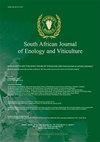巴塔哥尼亚黑皮诺葡萄酒中植物乳杆菌UNQLp 11的全基因组测序
IF 1.1
4区 农林科学
Q4 FOOD SCIENCE & TECHNOLOGY
引用次数: 7
摘要
植物乳杆菌UNQLp 11菌株是从阿根廷北巴塔哥尼亚General Roca最古老的商业酿酒厂(110年历史)的巴塔哥尼黑皮诺葡萄酒中分离出来的,并证明了其在酿酒过程中的生存能力,并成功地进行了苹果酸-乳酸发酵。这项工作旨在获得UNQLp 11菌株的完整基因组,从该菌株的酿酒学特性分析其结构和预测基因的可能功能。基因组大小为3 534 932 bp,平均GC含量为44.2%,共有3 412个CDS,80个转座子和148个串联重复序列。对来自不同来源的14株植物乳杆菌菌株的基因组大小和基因含量进行了比较,其中UNQLp 11的基因组大小最大。计算机全基因组分析使我们能够证实,除了细菌素和胞外多糖外,还存在编码酶的基因,这些酶参与了几种具有酿酒学意义的代谢产物的合成。此外,可以推测这种菌株对不同环境的适应,因为它能够使用不同的基质进行生长。所有这些特征表明,优衣库11有潜力成为苹果酸乳酸发酵的良好发酵剂。本文章由计算机程序翻译,如有差异,请以英文原文为准。
Complete Genome Sequencing of Lactobacillus plantarum UNQLp 11 Isolated from a Patagonian Pinot Noir Wine
Lactobacillus plantarum UNQLp 11 strain was isolated from a Patagonian Pinot noir wine at the oldest commercial winery (110 years old) in General Roca, North Patagonia, Argentina, and has demonstrated its ability to survive during winemaking processes and successfully carry out malolactic fermentation. This work aimed to obtain the whole assembled genome of the UNQLp 11 strain, analysing its architecture and the possible functions of the predicted genes from the oenological properties of this strain. The genome size is 3 534 932 bp, with a mean GC content of 44.2%, 3 412 CDS, 80 transposons and 148 tandem repeats. A comparison between the genome size and gene content of 14 Lb. plantarum strains from different origins was performed, and UNQLp 11 exhibited the largest size. The in silico genome-wide analysis allowed us to confirm the existence of genes encoding enzymes involved in the synthesis of several metabolites of oenological interest, in addition to bacteriocins and exopolysaccharides. Furthermore, it is possible to speculate on this strain’s adaptation to different environments, as it is able to use diverse substrates for its growth. All these features suggest the potential of UNQLp 11 to be a good starter culture for malolactic fermentation.
求助全文
通过发布文献求助,成功后即可免费获取论文全文。
去求助
来源期刊
CiteScore
2.50
自引率
7.70%
发文量
1
审稿时长
>36 weeks
期刊介绍:
The South African Journal of Enology and Viticulture (SAJEV) publishes full-length original Research Papers, Research Notes and Review Papers on all subjects related to enology and viticulture. The SAJEV does not accept articles published in, or submitted to, other journals.

 求助内容:
求助内容: 应助结果提醒方式:
应助结果提醒方式:


